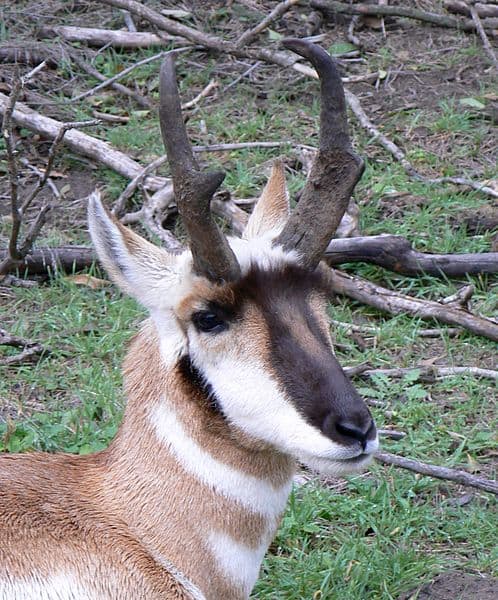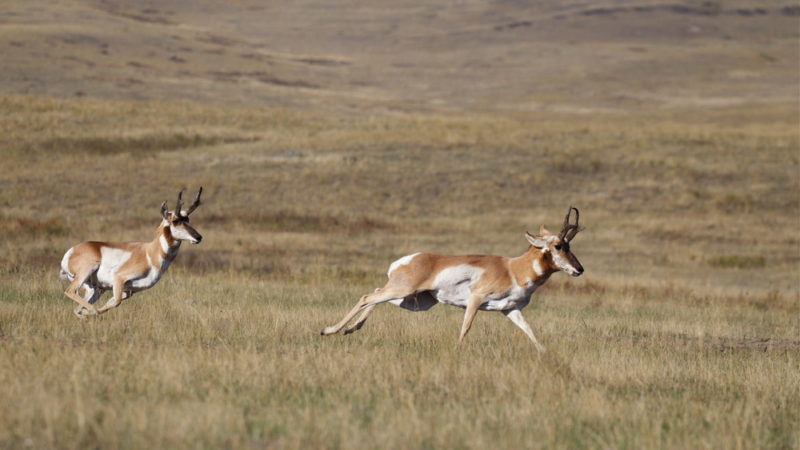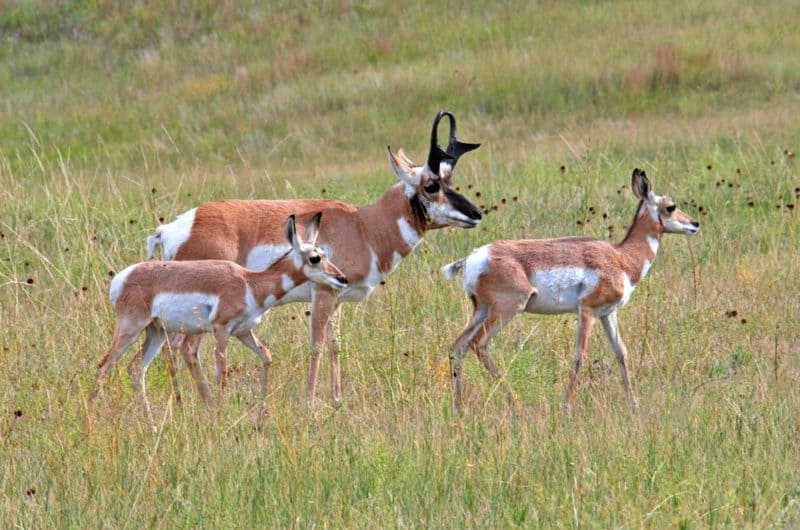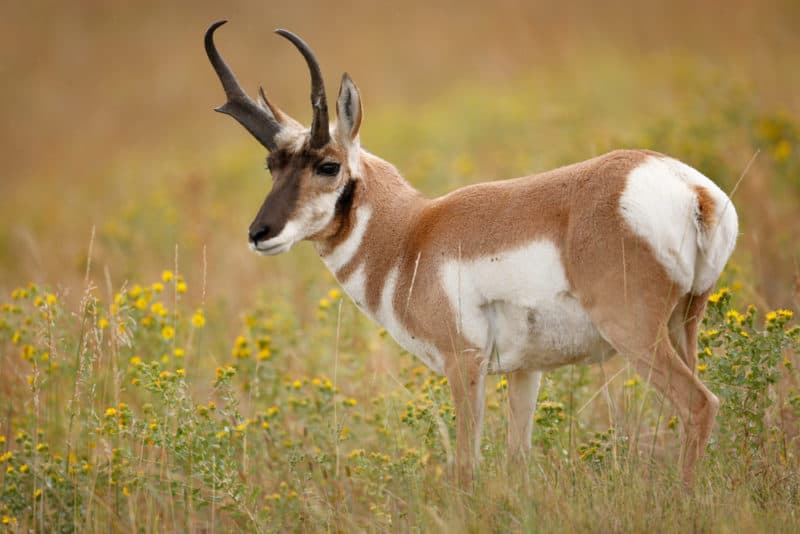There has been confusion between pronghorns and antelope. Maybe it’s because the animals have some resemblance in appearance or simply because the pronghorns are referred to as antelope. However, there are many differences between the animals. This article focuses on providing as many facts as possible surrounding the pronghorn. The next time you wonder, “Is a pronghorn an antelope?” Here’s your answer.
A Pronghorn is Not an Antelope
Although they resemble antelope and are often referred to as antelope, a Pronghorn is far different from an antelope. They are from the family, Antilocapridae. Their closest living relatives are the Giraffe and the Okapi.
True antelope are in the Bovidae family. There are 91 species of true antelope, most of which are from the African continent. The remainder of them lives in Asia.

Basic Pronghorn Facts
- They get their name from their prominent pair of horns displayed on their head. The horns are branched into two points. The longer back point curves backward while the shorter front point points straight up and forward like a prong.
- Their horns are made of bone base covered by a keratinous casing. This casing is shed and regrown every year.
- Both sexes of pronghorn have horns. The horns of the female are much smaller than those of the male.
- Pronghorns are approximately three and a half feet tall at the shoulder and four to five feet long.
- Their weight varies with gender. Pronghorn females weigh in at 75 to110 pounds compared to the male’s weight of about 90 to 140 pounds.
- Pronghorns are low jumpers, and they choose to go under rather than jumping over.
- When in a group, pronghorns are referred to as a band or a herd
- The male pronghorn is referred to as a buck, while a female is referred to as a doe.
- A young one of a pronghorn is referred to as a fawn.
- When startled, pronghorns raise the hair on their rump, and the white patch can be spotted miles away.
- Pronghorns are herbivorous and ruminants meaning they have a complex multi chamber stomach to aid in the digestion of low value cellulose material. Ruminants also chew their cud.
- Pronghorn herds migrate 150 miles twice a year between Wyoming’s Green River Basin and Grand Teton National Park. Of North America’s land mammals, only the Cariboo has a longer migration.
- The pronghorn is the second fastest land mammal in the world, after the cheetah.
- These animals don’t drink much water as they rely on the moisture they take in from plant consumption for hydration.

Family
As noted, pronghorns are not related to the antelope in any way despite their naming. Instead, they are the sole progenies of an ancient dear-like family known as Antllocapridae. Although this family was initially subdivided into two subfamilies, one subfamily in extinction plus the modern pronghorn, the distinctions seem invalid. Research has found the pronghorn to be close to the Giraffidae that forms a sister group to the bovids and cervids. As a result, there is a debate on whether to classify the pronghorn in their own family or include them in the Bovidae o Cervidae.
Pronghorn Subspecies
Although genetic evidence employs that only three subspecies of pronghorn should be recognized, five subspecies have been named. The five have been named based on minor differences in location, size, and color. They include:
- Americana Pronghorn (A. a. americana)- This species lives in the United States and Canada.
- Oregon Pronghorn (A. a. oregona)- Oregon Pronghorns are sometimes lumped in with Americana Pronghorns. This group includes pronghorns found in Oregon, California, Idaho, and Nevada. However, DNA analysis determined that these species are not different from the Americana, suggesting that they be considered Americana.
- Mexicana Pronghorn (A. a. mexicana)- In this subspecies, the pronghorns have a reduced mane, more pale coloration, and a thinner muzzle than Americana. They are native to the southwestern United States and Mexico. These animals are endangered. Poaching and destruction of their habitat due to overgrazing are the two main culprits that have led to their endangered status.
- Baja California Pronghorn (A. a. peninsularis)- The range of these animals is on the Baja California peninsula of Mexico. These are pronghorns with shorter and rougher horns. Their facial markings are darker brown. The Baja California pronghorn is a critically endangered subspecies of pronghorn. The wild population is estimated at 200.
- Sonoran Pronghorn (A. a. sonoriensis)- These are the smallest pronghorns with a smaller skull and only slightly differ from the Mexicanas. These animals have been on the endangered species list since 1967. As the name implies, the Sonoran pronghorn’s range encompasses the Sonoran Desert in southwest Arizona and the northern part Sonora in Mexico. There are approximately 500 surviving Sonoran pronghorn. A fifth of those are in the United States.
Pronghorn Vision
A pronghorn has depth perception and is very curious with excellent eyesight when it comes to vision. The animal can detect and spot a slight movement up to 3 miles (5km) away. Pronghorns have an eyeball of about 1.4inches (3.6 centimeters) in diameter. This makes them have enormous eyes in North American ungulate relative to the body size. This large protruding enables the pronghorn to have a 320 degrees field vision, and the long black eyes lashes act as sunshades.
When it comes to color vision, pronghorns see shades of gray just like other ungulates.

Pronghorn Speed
The pronghorn is by far the fastest land mammal in the new world as it is built for maximum predator evasion through running. However, it is referred to as the second-fastest land animal after the cheetah. They can maintain a high rate of speed for a much longer time than a cheetah can.
It isn’t easy to measure the top speed as it varies between individuals and the distance covered. However, pronghorns can run up to 88.5 km/h (53.09 mph) for 0.8 (.47 miles), 67 km/h(41.60mph) for 1.6 km(.994Miles), and 56 km/h(34.77mph) for 6 km (3.72 miles).
A newborn can take its first steps within 30 minutes after birth, and within four days, it can outrun a human. After one week, they can run faster than a horse.
So why do pronghorns need to be so fast? Some researchers speculate that the pronghorn evolved alongside a now-extinct North American Predator known as the False Cheetah. If this is the case, Pronghorns needed all that alertness and speed to stay away from these ancient fleet-footed predators.

Pronghorn Population
Globally, the pronghorn population is estimated to be about one million individuals, where three quarters are mature individuals. The population is stable in most parts of the world except for Mexico, where the population may be declining due to high cases of illegal poaching.
Some of the pronghorn’s highest numbers are found in the state of Wyoming. However, the antelope population has been declining over the last decade, and to date, there are slightly more than 400,000 within the state.
Pronghorn Antelope Habitat
The pronghorn species is mainly found in western and central North America. Their habitat can range from sea level to about 3,500 meters above sea level. They are mainly adapted to live in grassland regions as they are herbivorous, but some herds can also be found in deserts. They feed on shrubs, forbs, cacti, vegetation, and grass. Therefore, you can find pronghorns in open grasslands, semi-arid prairies, or sagebrush flats.
They are mainly found in Canada: southern Alberta and Saskatchewan. In Mexico: Baja California, Sonora, Hidalgo. In America: Texas, Kansas, North Dakota, Montana, Oklahoma, Colorado, Washington, Oregon, New Mexico, Nebraska, South Dakota, Wyoming, Nevada, Idaho, Utah, California, Arizona.
Predators
The main predators of pronghorns include wild dogs, bobcats, coyotes, wolves, and cougars. However, golden eagles have also been reported to feed on fawns. In the southwestern United States and Northern Mexico, jaguars are also likely to prey on the pronghorns in their native range.
Over most of their range, this once-endangered species is now quite numerous, thanks to the conservation programs. Habitat protection and hunting restrictions have contributed significantly to the recovery of the pronghorn population; now, they can be regally hunted to regulate their population.
Recent Posts
The only venomous snakes in Washington State are Northern Pacific Rattlesnakes. The Northern Pacific Rattlesnake (Crotalus oreganus oreganus) is a sub-species of the Western Rattlesnake. Anyone...
Skunks are not classified as true hibernators. But they go into a state of torpor when the weather gets cold. Skunks are light sleep hibernators, along with opossums, bears, and raccoons. ...

